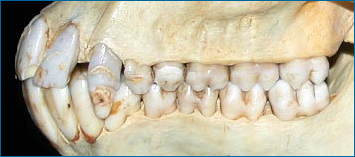Leslea’s research on baboon teeth is motivated by a desire to understand a central aspect of evolution: variation. At a glance, all baboons might look alike, but to a careful observer, each is unique — from its personality to the shape of its teeth. Leslea hopes to unravel the genetic and environmental factors that lead to this diversity: “Variation is the key to everything. The theme of my lab is understanding variation.”
Variation is the raw material of evolution. Natural selection and other mechanisms of evolution work on the variation within a population — so without variation, there would be no evolution. However, there are two possible sources of variation: the environment and genes — in other words, nature and nurture. To understand these two components, imagine a field of corn plants with varying heights. If the variation in height were entirely environmental in origin (e.g., due to quality of soil, amount of sunlight, temperature, etc. — the “nurture” end of the spectrum), tall parents wouldn’t sire particularly tall offspring and siblings wouldn’t necessarily resemble each other in height, since height would only be affected by the environment and not by which gene versions the offspring carry. On the other hand, if the variation in height were entirely genetic in origin (the “nature” end of the spectrum), then every plant’s height would reflect the genes it inherited from its parents and nothing else — no matter how much or little you watered a particular plant, it would grow to the same height. Since only those traits with some genetic basis can be inherited by offspring (a key component of evolution), only genetically-based traits can evolve.
In reality, of course, an organism’s phenotype — the physical trait it ends up having (e.g., being four feet tall) — is usually the result of both genetic factors, environmental factors, and the interactions between them. This is certainly true of the shape of baboon teeth. Some aspects of the bumps and ridges of the teeth are controlled by which gene versions the animal carries; other aspects of the teeth are environmental and are affected by what foods the animal ate, how it chewed, which nutrients it received as it developed, etc. Leslea studies baboon teeth in order to figure out which components of that tooth phenotype stem from genetic sources.

Get tips for using research profiles, like this one, with your students.

